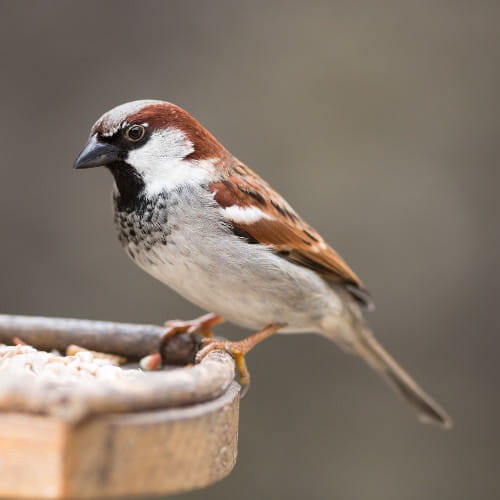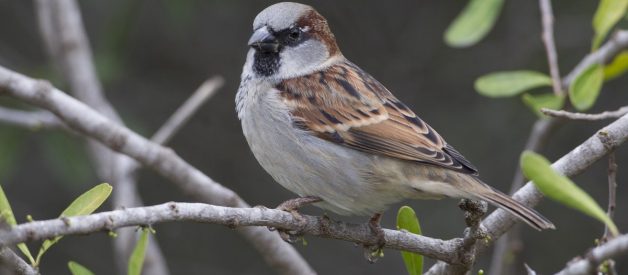Lots of people refer to Sparrows as ?the little brown birds? but in actual fact they are so much more. Sparrows have colonised bushes in the UK for almost a century. They live in large groups and have a ferocious appetite, but life for them is becoming tougher.
?Sparrows are finch-like birds. They have stout bodies, rounded wings and broad heads, with deep, conical bills adapted for seed-eating.? RSPB
Once one of Britain?s commonest birds, numbers have crashed in recent years. London lost three-quarters of its sparrows between 1994 and 2000. It is now a bird that we take for granted. Ask anyone older than 30 and they will tell you that House Sparrows were a common site in most gardens and parks. This isn?t the case today.
Sparrow Decline
In some urban areas the population has fallen by 99%. The reasons are largely unknown but Sparrows now site on the red status list for birds in the UK. Something that isn?t wildly acknowledged by those that once loved their little brown birds.
Causes for the rapid recent declines, particularly in urban and suburban environments, remain largely undetermined, although research is underway that aims to establish the cause(s), and develop conservation solutions.
Declines in rural house sparrow populations are thought to be linked to changes in agricultural practices, particularly the loss of winter stubbles and improved hygiene measures around grain stores.
House sparrow numbers were not monitored adequately before the mid-1970s. Since then, numbers in rural England have nearly halved while numbers in towns and cities have declined by 60 per cent.
Love or Hate
There isn?t a bird that?s happier in the company of humans, maybe the Robin, but sparrows position their colonies close to use in Urban communities. You rarely find Sparrows outside of urban spaces. They don?t migrate but sometimes flock to the countryside in the late summer to feed on the ripening grain fields.

We?ve had a love hate relationship with these little birds for quite some time. From the mid-18th century most parishes had sparrow clubs with the sole objective to destroy as many sparrows as possible. Bounties were paid for sparrows until the late 19th century, when it was accepted that the control measures did not work. They are grain eaters and thus they have been disliked around the world for their crop destruction.
Sparrows and Feeders
House Sparrows are often on the feeders in large numbers. If you have them in your garden you know about it. House sparrows are aggressive tend to dominate feeders in gardens and prevent other birds from getting to the food. They harass other birds and steal their food and take over their nests, particularly house martins.
They eat a variety of food but in particular enjoy seeds, mealworms and nuts. We have developed an Urban Bird mix that has a specific aim in increasing bird numbers. You might find that having separate feeders in the garden for your sparrows helps to support other birds in eating.
Quick fire House Sparrow Facts
- The house sparrow?s flight is direct with continued flapping and no periods of gliding, averaging 45.5 km/h (28.3 mph) and about 15 wingbeats per second
- The house sparrow is a very social bird. It is gregarious at all seasons when feeding, often forming flocks with other types of birds.
- They are found in widely varied habitats and climates, but are absent from uninhabited woodlands, deserts, forests, and grasslands.
- The average life expectancy of a wild sparrow is almost always under 10 years, and usually closer to 4?5 years. The oldest known wild house sparrow lived for nearly two decades; it was found dead 19 years and 9 months after it was ringed in Denmark.
How to spot a tree sparrow
Tree sparrows are slightly different. Smaller than a house sparrow and more active, with its tail often cocked. It has a chestnut brown head and nape (rather than grey) and white cheeks and collar with a contrasting black cheek spot. They are shyer than house sparrows in the UK and are rarely associated with people.

The tree sparrow is also in decline. UK tree sparrow populations has suffered a severe decline, estimated at 93 per cent between 1970 and 2008. However, recent Breeding Bird Survey data is encouraging, suggesting that numbers may have started to increase, albeit from a very low point.
See if you can spot the different birds in your garden for the Big Garden Birdwatch in January (26?28th Jan).
Quick fire facts about Tree Sparrows
- Unlike house sparrows, both sexes of tree sparrows are identical in appearance, with no seasonal change in plumage
- Though the adults are chiefly seed-eaters, the young depend on a diet of insects.
- They are hole-nesters and will readily use nest boxes. Colonies can be established by providing a number of suitable nest boxes in a small area.
- Once a pair bond has been established, the two birds remain in company for much of the time, feeding, bathing and preening together.
You can support your tree & house sparrow colonies with our Urban Bird Mix. To find out more about the mix and what?s in the bag visit our Urban Bird Blog. To find out more about the decline in sparrows check out the RSPB website.


